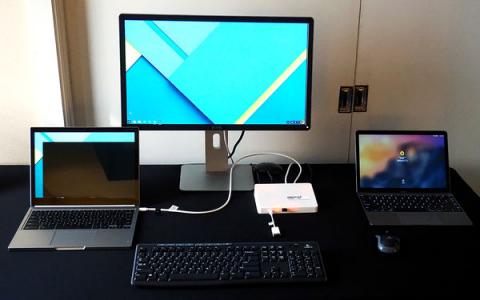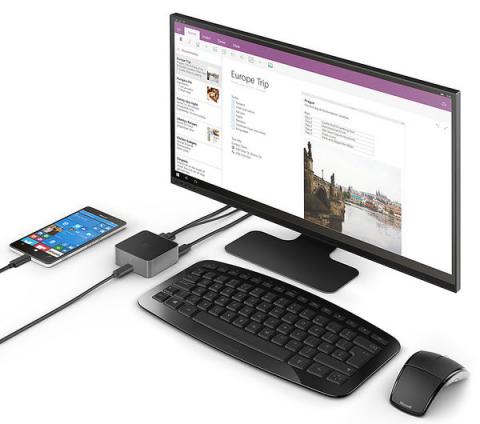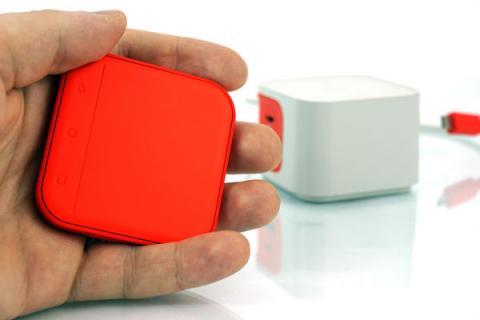Analogix USB-C Chip Achieves USB-IF Certification, And Other Stories
Analogix, a company that makes semiconductors for all manner of displays, as well as a number of display adapters, had several announcements to make. Its ANX7428 chip was just certified for USB Power Delivery (PD) by the USB-Implementer’s Forum (USB-IF), we learned that its ANX7816 SlimPort converter lives in the Microsoft Lumia 950 and 950 XL, and its SlimPort Nano Console hit its crowdfunding goal.
USB-IF Certification Is A Big Deal
Although gaining USB-IF certification sounds like something that 1) just happens and 2) is not important or interesting, it’s actually a significant milestone.
A USB product cannot bear any official USB branding or nomenclature (yes, it’s all trademarked) unless it has been certified by the USB-IF, and the process of certification is no rubber stamp. In a conversation with folks from the USB-IF earlier this year, we learned about the extensive, exacting and precise process by which the group ensures both that the USB chips that hit the market (such as those made by Analogix) and also the implementations of those chips in individual products adhere completely to USB specifications and have passed key quality control tests. A lack of certification does not necessarily mean that a given chip or implementation is not up to par, but the granting of certification guarantees that it certainly will be.
To wit, not all of Analogix’s chips are USB-IF-certified, yet, but an Analogix rep told us that the whole ANX74XX family -- the ANX7418, ANX7408, ANX7402 and ANX7401 -- should receive the USB-IF stamp of approval soon via the group’s “Certification by Similarity” process.
In the case of the ANX7428, its Power Delivery engine (which it shares with its aforementioned siblings) is the chief feature. The chip family is billed as a “low cost solution for mobile devices such as smartphones, tablets, and notebooks” and features USB-C port controllers (up to four on a single device such as a notebook) that offer up to 100 W power delivery, USB 2.0 charging, and SuperSpeed USB (5 Gbps) data transfer. They also support DisplayPort via an AltMode, meaning a device with one of these chips can send DisplayPort over a USB-C connector.

The PD aspect is important because it allows a device to negotiate power with any device it’s connected to. For example, if your notebook or smartphone and your monitor both support USB PD and both have USB-C ports, your monitor can charge your notebook or smartphone while they’re connected, even as your device outputs its display.
The Lumia 950/950 XL, Analogix, And New Ways Of Doing Things
If you’ve been tracking the mobile market at all lately, you’ll recognize some of these capabilities as perfectly suited forMicrosoft’s new Lumia 950 and 950 XL (with Continuum and the optional Display Dock) as well as the impending Liquid Jade Primo smartphones from Acer -- which also will sport Continuum and have their own version of the Display Dock, and peripherals.
Analogix is actually pushing that very thing in its marketing materials, adding this quote from Bill Lempesis, Executive Director at VESA (which maintains the DisplayPort spec) in a press release:
DisplayPort over USB-C delivers the highest resolutions at the lowest power, which makes it ideally suited for mobile computing devices, such as the recently introduced Microsoft Lumia 950 and 950 XL. The DisplayPort audio/video out capability enables new use-cases, such as Continuum for phones, effectively allowing you to use your phone like a PC.
In the same release, USB-IF President and COO Jeff Ravencraft posited that the USB PD spec is key to enabling Alt Modes, such as DisplayPort over USB-C.

At this point, we should point out that the Lumia 950 and 950 XL have the ANX7816 converter inside, not one of the ANX74XX chips. However, the ANX7816 can output 4096x2160p30, and when paired with an appropriate partner chip (such as the ANX77XX-family [PDF] in the Display Dock), it can convert HDMI to DisplayPort, which can then be converted to HDMI, DVI or VGA on the receiving end. (You can see its full specs and support here [PDF].)
SlimPort Nano Console, Coming Soon
A final bit of news from Analogix concerns its neat little SlimPort Nano Console. When I wrote up my hands-on experience with it back in October, the Indiegogo campaign still hadn’t hit its goal, but an Analogix rep told me that eventually it reached 102 percent of its funding, and you can still snag a unit via the “In Demand” status for as low as $34.

The full-scale launch is expected in January 2016, and at that time you’ll be able to purchase one from Amazon (and presumably other etailers and retailers), but for a price closer to the $59 MSRP.
______________________________________________________________________
Seth Colaner is the News Director at Tom's Hardware. He curates and edits the news channel and also writes on a variety of topics. He has an unnatural level of interest in all things USB-C.
Follow him on Twitter @SethColaner. Follow us on Facebook, Google+, RSS, Twitter and YouTube.
